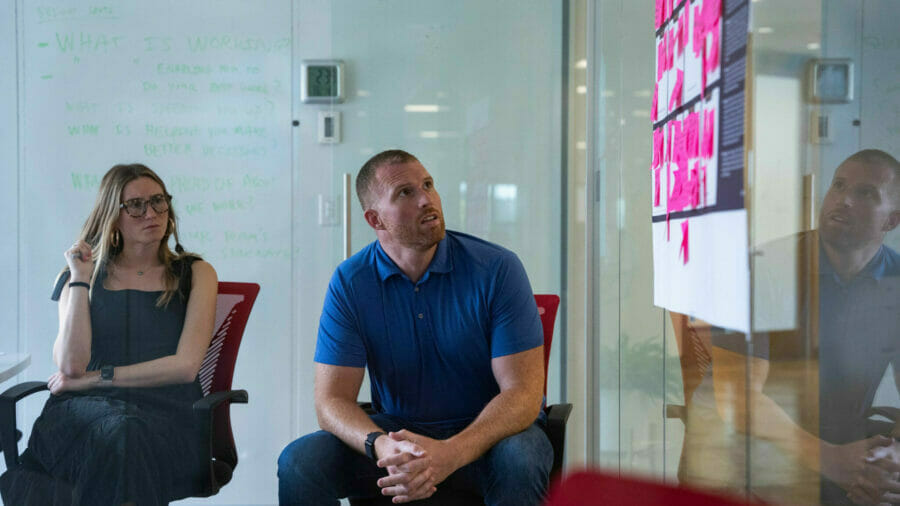In our recent people management study, 76 percent of employees surveyed said that great managers recognize good work. There are many ways to reward employees. But, when you manage people with different needs and behaviors, what does effective recognition look like?
Employee encouragement and feedback are important topics in workplace culture. Most managers know they should be recognizing and rewarding their employees–but few know the best way to do that.
A pizza party or happy hour might be fun for some employees, but excruciating for others. A coveted parking spot would reward an employee who seeks prestige but might embarrass someone who doesn’t like to be on display. A handwritten note of thanks might be very meaningful to one employee but feel cheap to the next.
While choosing the right reward can feel like a balancing act, one thing’s for sure:
As human beings, employees thrive on positive feedback.
According to Psychology Today, feeling appreciated is a cornerstone of positive self-worth. It also strengthens the bond between two individuals.
Studies show that workplace recognition is important to employees of every generation. And it’s a key driver in employee engagement. In fact, OGO found that 40 percent of American workers would put in more effort if their employers recognized them more often.

As we’ve said before, people who have passion and energy for their jobs put in more discretionary effort. And aside from job fit (working in a role you’re naturally suited for), there’s nothing quite as energizing as being recognized by your boss for your hard work.
Unfortunately, managers fail at recognizing their employees in meaningful ways.
Here are some stats:
- 82 percent of employees don’t feel recognized by their bosses (OGO)
- 83 percent of organizations suffer a deficit in employee recognition (Bersin by Deloitte)
- 17 percent of employees believe their managers know how to recognize them well (Bersin by Deloitte)
The disconnect is deadly. Employees who feel unappreciated are less productive and have higher rates of attrition. But, employers who get recognition right enjoy upticks in retention, engagement, and productivity. They also see less absenteeism.
Finding meaningful ways to reward employees makes good business sense.
Employees with “excellent” well-being had a 19 percent higher work output than employees with “poor” well-being, according to the O.C. Tanner Institute.
Gallup advised organizations that want to retain employees or boost organic growth to focus on employee recognition.

And according to Bersin by Deloitte, “companies which fall into the top 15 percent in building a ‘culture of recognition‘ have 46 percent lower rates of voluntary attrition.”
To maximize engagement and minimize turnover, make appreciation part of your day-to-day culture.
Here are five ways to reward employees and recognize great work on your team:
Join 10,000 companies solving the most complex people problems with PI.
Hire the right people, inspire their best work, design dream teams, and sustain engagement for the long haul.
1. Say the words “thank you” to your employees, and mean them.
It’s surprising how often leaders throw rewards like parties or bonuses at employees without ever saying “thank you.” Hosting a monthly beer night to thank employees in bulk is nice, but it isn’t going to cut the mustard. It won’t make your employees feel special and it won’t deliver the engagement results you want.
Take the time to understand what your employees are bringing to the table. Then thank them—and really mean it. Dropping by someone’s desk with words of heartfelt thanks can do more for morale than a whole season of free drinks. You could even try penning a handwritten note and mailing it to the employee at home.
2. Be specific about what an employee did that was so great.
Being specific about why you’re recognizing an employee can actually give that person an extra dose of dopamine. Analytical employees in particular like hearing what they’ve done well. This is because it transforms praise from something empty to something targeted and tangible.
The bonus of being specific? Your employees will understand exactly what you like to see, and they’ll do more of it.

3. Personalize employee rewards.
By “gifting” an introvert tickets to a sporting event with you, you could be burdening them with forced fun. A work from home day might be a more appreciated way to reward this employee. Someone who’s driven to receive public praise might prefer the prestige of being employee of the month—and getting that coveted parking spot.
Use what you know about your employee’s goals, needs, and traits to tailor your reward to him or her. Understanding your people is key to keeping your best employees motivated and engaged.
Not sure what your employees would like? Don’t be afraid to ask them. One company we know asks employees what their favorite stores and snacks are, and how they prefer to be recognized, as part of onboarding. Then they use that intel to tailor rewards and recognition down the road.
4. Use gift cards or monetary bonuses.
There are conflicting points of view about the efficacy of using gift cards, money, and other tangibles as a way to reward employees. Some experts say that these rewards don’t inspire loyalty. Also, employees need to pay taxes on cash awards, which can leave a sour taste in one’s mouth.
However, once again, it all comes down to understanding the employees you manage. Are your employees entry-level and strapped for cash? If so, money can help them pay their bills—and that can lower stress levels.
If you decide to give money or gift cards, consider outlining specific times when these rewards should be given. For example, you might choose cash rewards when an employee’s hard work has gone above and beyond. This way they’ll feel less transactional and more special. Cash can be a great way to make employees happy, but our advice is to consider making cash or gift cards just one part of your employee appreciation program.
5. Let your team do the gifting.
Allowing employees to reward their peers can be good for employee engagement. Consider having employees nominate each other for important quarterly or annual rewards. Make sure you require them to be specific about why they’re nominating this person—you don’t want employee appreciation to become a popularity contest. When it comes time to present the award, read nominations out loud so the recipient can hear all the nice things his or her colleagues said.
Employees like to receive kudos from peers. At Google, employees recognize each other through a successful internal peer recognition and reward system. At Zappos, employees nominate their peers for rewards according to how well they lived up to or promoted company values.
How much should you be spending on employee rewards? Experts recommend setting aside one percent or more of payroll for recognition and rewards. If you don’t have that room in your budget, spend what you can on tangible gifts and be sure to say thank you often.


